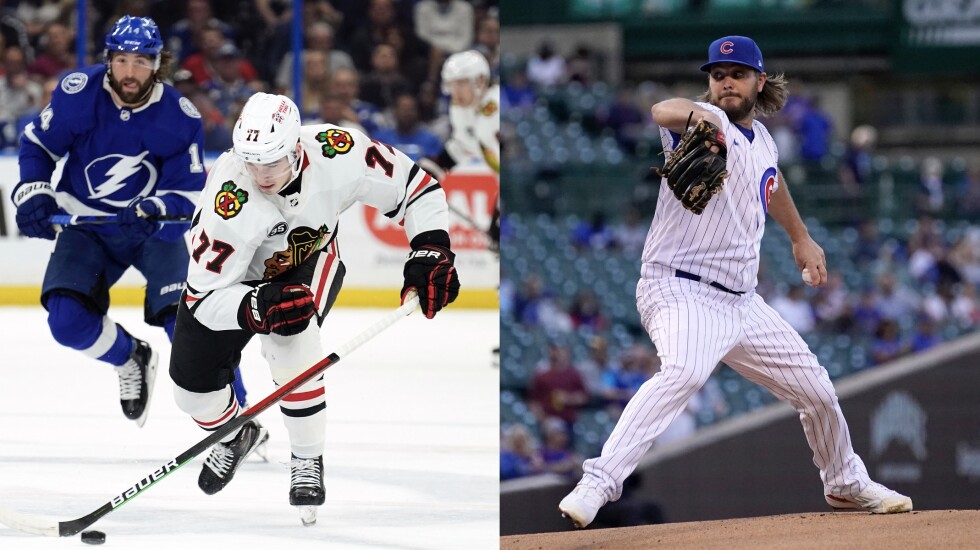
Hockey is a sport of extreme fluidity, of constant movement by a dozen players making in-the-moment decisions that interact -dynamically with each other.
Baseball is a sport of chronological, singular events, hundreds of which combine to complete a game.
The latter is enormously more quantifiable, and the Cubs, for instance, have mastered the systems that most accurately quantify it and use that information for a supposed competitive advantage. But so has nearly every other MLB team, diminishing the advantage.
That’s not the case in the NHL, where some analytics have taken root over the past decade but not nearly to the same degree they have in baseball. That’s a product of the sport’s complexity, not an indictment on the smart minds behind hockey’s analytics movement.
The Blackhawks, who hadn’t exactly been leading the analytics movement, now are attempting to race well ahead of the curve and adopt a more MLB-like -approach.
That’s why they hired Kyle Davidson, who built the Hawks’ new in-house analytics department last summer, as their general manager. Then Davidson took things a step further, hiring longtime Cubs executive Jeff Greenberg as his associate general manager.
But it’s easier said than done. The challenge that lies ahead is sizable.
“[In] baseball, most if not all teams have put in place pretty modern, sophisticated systems to process that information and then leverage it to actually drive their decision-making,” Greenberg said this week. “That’s something that hockey is probably behind in right now, and I’m here in part because we want to try to fill that gap.
“What we’ve seen in baseball is [that] having the information . . . in itself isn’t enough. It comes down to, ‘How are you using those things? How are you leveraging those things effectively? How are you getting them onto the field to make your players better?’ ” . . . It’s [about] that integration to really impact what you’re doing, and that’s ultimately what we’re trying to do. We’re not trying to build good systems or processes for the sake of building good systems and processes. We want it to really help drive what we’re doing and how we’re acquiring players, how we’re developing our players, what we’re doing in-game. There [are] principles and lessons in baseball we can apply in hockey.”
Greenberg, a devoted lifelong hockey fan despite having worked exclusively in baseball management since college, and Davidson, a baseball fan during hockey offseasons, bonded over texts and calls after Davidson beat out Greenberg in March for the GM job.
Their resulting Hawks front-office marriage, complemented by the presence of a more old-school hockey guy in Norm Maciver, will test the feasibility of integrating the two sports’ ways of operating more than anyone has attempted before.
“It starts with knowing how the process and the steps of, ‘How did baseball get there?’ ” Davidson said after the season. “So we have to figure out how hockey gets there. And who better to get us to that point than someone who’s done it in another sport already?
“Let’s be honest: We’re probably not going to be able to get all of the predictive information that they can in baseball just based on the nature of the sport. But if we can get a few, then that’s huge value. [With Jeff] bringing that level of insight into the process of getting to that point, that’s where I need to fill the gap for myself. I’ve never gone through that process before. He has. So he brings a big experience bank and just the understanding of, ‘If you were to do it again, what steps would you avoid? What things would you do a little bit better?’ ”
Davidson and Greenberg’s descriptions are lacking in specific details about what those systems will entail — and understandably so, considering the Hawks want to pioneer this crossover.
Nonetheless, Davidson admits he envisions software — unmistakably similar to the Cubs’ so-called “Ivy” system — that centralizes information into an efficient and accessible database.
“We want to get to a point where all of our information . . . [is] housed in one system, and that’s a big build,” he said. “[It’ll be] a central housing unit for all your information. It’s the heartbeat of the operation, so you know what’s going on in every area and you don’t have to reach out to 10 different people to try to figure out who they talked to, what they said.”
That information won’t merely be the hockey equivalents of WAR, BABIP, spin rate, exit velocity, the data that prompts defensive shifts and all the other in-game analytics that have made baseball, for better or worse, such a computer-driven game. That information also will include prospect scouting reports, coaching insights, front-office efficiency evaluations and more.
The Hawks will need to hire developers to help build that software — a few of the many personnel changes and additions yet to come this offseason that will round out the leadership structure beneath Davidson, Greenberg and Maciver.
But Greenberg will head the project. That freedom is why he was willing to even consider leaving Addison Street for Madison Street. He talked extensively with former and current Cubs presidents Theo Epstein and Jed Hoyer, weighing their advice about organization-building, as well as for him personally, before agreeing to make the move 36 blocks south. Now only time will tell if he and the Hawks can learn to swim in these uncharted-in-hockey waters.
“I had a pretty good sense that baseball was pretty far ahead,” Greenberg said. “I didn’t know all the details, but that was one of the reasons why the [job] initially was pretty interesting. My sense was there was an opportunity to move the needle and close that gap between where hockey is now and where baseball has gone over the last 10 years.
“It wasn’t something that I was actively looking to do, [but] this opportunity in particular . . . was the right place, right time.”







